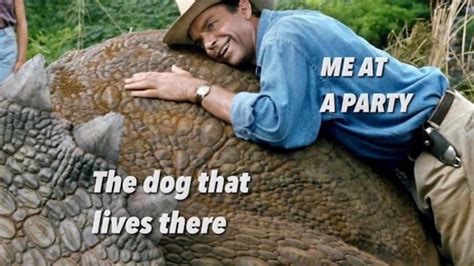
A baby cockatoo’s uncanny resemblance to the iconic roar of a velociraptor from “Jurassic Park” has catapulted it to viral fame, captivating audiences worldwide with its adorably terrifying screech. The video, showcasing the young bird’s startling vocalization, has amassed millions of views, shares, and comments across various social media platforms, turning the feathered fledgling into an overnight sensation.
The viral video features a sulphur-crested cockatoo chick named Kevin, owned by a bird enthusiast residing in Australia. It was initially uploaded to platforms such as TikTok and Instagram. It wasn’t long before users noticed the striking similarity between Kevin’s screech and the unforgettable sound effects used for the velociraptors in Steven Spielberg’s blockbuster film. The unusual sound is not typically associated with cockatoos, particularly baby ones, making the video all the more captivating.
“I wasn’t expecting that at all,” one commenter wrote on TikTok, perfectly capturing the surprise and amusement shared by many viewers. Another user jokingly suggested that Kevin was “auditioning for the next Jurassic Park movie.”
The unexpected popularity of the video highlights the internet’s penchant for animal videos with unique and amusing characteristics. The juxtaposition of a cute, fluffy baby bird producing a sound associated with a fearsome prehistoric predator creates a humorous contrast that resonates with a wide audience.
The video’s virality also points to a broader appreciation for animal sounds and behaviors, with many people expressing fascination with the complex vocalizations of birds. Cockatoos, in particular, are known for their ability to mimic sounds, but Kevin’s “Jurassic Park” impression is exceptionally unique.
The owner of Kevin, who prefers to remain anonymous, has expressed delight at the positive reception the video has received. They have also taken the opportunity to educate viewers about cockatoo care and conservation. “It’s amazing to see how many people have enjoyed Kevin’s little roar,” they said in a statement. “I hope it also encourages people to learn more about these incredible birds and the importance of protecting them.”
Cockatoo Vocalizations and Mimicry
Cockatoos are highly intelligent and social birds known for their distinctive crests and powerful beaks. They are native to Australia, Indonesia, and New Guinea, inhabiting a variety of habitats, including forests, woodlands, and urban areas. Their vocalizations are complex and diverse, ranging from soft contact calls to loud, piercing screams used for communication and territorial defense.
Their capacity to mimic sounds is remarkable. They are adept at learning and replicating a wide range of noises, including human speech, environmental sounds, and even other animal calls. This ability is attributed to their complex syrinx, the avian vocal organ, which allows them to produce a wide range of frequencies and tones. Some cockatoos can even mimic specific human voices or household sounds with remarkable accuracy.
However, it is important to distinguish between mimicry and true understanding of language. While cockatoos can learn to associate specific sounds with certain actions or objects, they do not possess the same level of cognitive understanding as humans. Their mimicry is primarily driven by social learning and a desire to communicate within their environment.
Kevin’s “Jurassic Park” scream is an unusual example of mimicry, as it is unlikely that he learned the sound from other cockatoos or his natural environment. It is more probable that he was exposed to the sound through media, such as television or movies, and learned to replicate it through observation and imitation. This ability highlights the remarkable plasticity of the cockatoo brain and their capacity to learn and adapt to novel stimuli.
The Appeal of Animal Videos
The internet is awash with animal videos, ranging from cute kittens and playful puppies to exotic wildlife performing extraordinary feats. These videos have a profound impact on viewers, evoking a range of emotions, from joy and amusement to awe and wonder. The appeal of animal videos can be attributed to several factors.
Firstly, animals possess an inherent ability to capture our attention. Their movements, behaviors, and expressions are often unpredictable and fascinating. They lack the self-consciousness and social inhibitions that often constrain human behavior, allowing them to express themselves freely and authentically.
Secondly, animal videos can provide a sense of connection to the natural world. In an increasingly urbanized and technology-driven society, many people have limited opportunities to interact with animals and experience the wonders of nature firsthand. Animal videos offer a virtual escape, allowing viewers to vicariously experience the beauty and diversity of the animal kingdom.
Thirdly, animal videos can be incredibly therapeutic. Watching animals play, interact, and overcome challenges can be uplifting and inspiring. They can remind us of the simple joys of life and help us to appreciate the beauty of the present moment. Studies have shown that watching animal videos can reduce stress levels, lower blood pressure, and improve mood.
Finally, animal videos can serve as a powerful tool for education and conservation. By showcasing the unique characteristics and behaviors of different animals, these videos can raise awareness about the importance of protecting wildlife and their habitats. They can also inspire viewers to take action to support conservation efforts.
Cockatoo Conservation
While some cockatoo species are thriving, others face significant threats, including habitat loss, poaching, and the illegal pet trade. Several species are listed as endangered or vulnerable by the International Union for Conservation of Nature (IUCN).
Habitat loss is a major threat to cockatoos, as they rely on forests and woodlands for food, shelter, and nesting sites. Deforestation, agriculture, and urbanization have all contributed to the loss of cockatoo habitat, particularly in Indonesia and New Guinea.
Poaching and the illegal pet trade also pose a significant threat to cockatoo populations. Cockatoos are highly sought after as pets due to their intelligence, beauty, and ability to mimic sounds. However, many cockatoos are captured from the wild and smuggled into other countries, often with high mortality rates.
Conservation efforts are underway to protect cockatoos and their habitats. These efforts include habitat restoration, anti-poaching patrols, and public awareness campaigns. Organizations such as the World Parrot Trust and BirdLife International are working to support cockatoo conservation efforts around the world.
Individuals can also contribute to cockatoo conservation by supporting sustainable forestry practices, avoiding the purchase of illegally traded pets, and donating to conservation organizations. By working together, we can ensure that cockatoos continue to thrive in the wild for generations to come.
The Sulphur-Crested Cockatoo
The sulphur-crested cockatoo (Cacatua galerita) is a relatively large white cockatoo found in Australia, New Guinea, and some Indonesian islands. They are adaptable birds and can be found in various habitats, from forests and woodlands to urban areas. Sulphur-crested cockatoos are known for their distinctive yellow crest, which they raise when alarmed or excited.
These cockatoos are highly social and typically live in flocks, sometimes numbering hundreds of individuals. They are intelligent and playful birds and are known to engage in a variety of social behaviors, such as grooming, playing, and vocalizing.
Sulphur-crested cockatoos feed on a variety of foods, including seeds, nuts, fruits, and roots. They use their powerful beaks to crack open nuts and seeds and to dig for roots and tubers.
Sulphur-crested cockatoos are relatively long-lived birds, with a lifespan of up to 70 years in captivity. They typically reach sexual maturity at around 3-5 years of age.
The sulphur-crested cockatoo is a protected species in Australia, but they are sometimes persecuted as pests due to their habit of damaging crops and property. However, they also play an important role in the ecosystem by dispersing seeds and controlling insect populations.
Ethical Considerations of Sharing Animal Videos
While animal videos can be entertaining and educational, it is important to consider the ethical implications of sharing them online. In some cases, animal videos may depict animals in stressful or harmful situations. It is important to be mindful of the potential impact of these videos on animal welfare and to avoid sharing videos that could encourage cruelty or exploitation.
It is also important to consider the privacy of animals and their owners. Some animal owners may not want their animals to be featured in viral videos. It is important to respect the wishes of animal owners and to avoid sharing videos without their permission.
By being mindful of the ethical considerations of sharing animal videos, we can help to ensure that these videos are used in a responsible and ethical manner.
Future of Viral Animal Videos
The popularity of viral animal videos shows no signs of abating. As social media platforms continue to evolve and expand, the potential for animals to become internet sensations will only increase.
Advances in technology are also contributing to the rise of viral animal videos. Smartphones with high-quality cameras make it easier than ever to capture and share videos of animals. Social media platforms are also developing new features that make it easier to discover and share animal videos.
The future of viral animal videos is likely to be shaped by a number of factors, including technological advancements, social media trends, and ethical considerations. However, one thing is certain: animals will continue to play a prominent role in the online world.
Conclusion
The story of the baby cockatoo with the “Jurassic Park” scream is a testament to the power of animal videos to capture the imagination and hearts of people around the world. The video’s virality highlights the unique and amusing characteristics of animals, the therapeutic benefits of watching animal videos, and the importance of protecting wildlife and their habitats. As the internet continues to evolve, animals will continue to play a prominent role in the online world, providing entertainment, education, and inspiration to millions of people. Kevin, the cockatoo, has inadvertently become an ambassador for his species, raising awareness and sparking curiosity about these intelligent and fascinating birds. His viral fame serves as a reminder of the joy and wonder that animals bring to our lives, and the importance of conserving their habitats for future generations to enjoy. The incident further stresses the power of social media and the internet in bringing unlikely animal stories to the forefront of public consciousness.
Frequently Asked Questions (FAQ)
-
What is the story about? The story is about a baby sulphur-crested cockatoo named Kevin whose scream sounds remarkably similar to the velociraptor roar from the movie “Jurassic Park.” This unusual vocalization has made the video of Kevin go viral, capturing the attention of millions online.
-
Where did the video originate, and where has it been shared? The video originated with Kevin’s owner, who resides in Australia, and was initially shared on platforms such as TikTok and Instagram. From there, it quickly spread to other social media platforms, gaining widespread attention.
-
Why is this video so popular? The video is popular because of the unexpected and humorous contrast between the cute appearance of a baby cockatoo and the fearsome sound associated with a predator like the velociraptor. This juxtaposition is amusing and captivating to a wide audience. It also highlights the fascination with animal sounds and behaviors.
-
What does the owner of the cockatoo say about the video’s popularity? The owner, who prefers to remain anonymous, is delighted by the positive reception of the video. They also hope it encourages people to learn more about cockatoos and the importance of their conservation. They were quoted saying, “It’s amazing to see how many people have enjoyed Kevin’s little roar… I hope it also encourages people to learn more about these incredible birds and the importance of protecting them.”
-
What are some of the threats facing cockatoos in the wild? Several cockatoo species face threats such as habitat loss due to deforestation, agriculture, and urbanization. They also face the risks of poaching and the illegal pet trade. Conservation efforts are underway to combat these threats and protect cockatoo populations.
-
How does a cockatoo learn to mimic sounds? Cockatoos are highly intelligent birds with a complex syrinx (the avian vocal organ), which allows them to produce a wide range of frequencies and tones. They learn to mimic sounds through social learning and observation, often associating sounds with specific actions or objects. They can mimic human speech, environmental sounds, and even other animal calls.
-
Is Kevin’s “Jurassic Park” scream a typical cockatoo vocalization? No, it is not. While cockatoos are known for their ability to mimic sounds, Kevin’s “Jurassic Park” scream is an unusual example. It’s more likely that he learned the sound from media, such as television or movies, and replicated it through observation and imitation, rather than from other cockatoos or his natural environment.
-
What is the conservation status of sulphur-crested cockatoos? The sulphur-crested cockatoo is a protected species in Australia. They are not currently listed as endangered or vulnerable. However, they sometimes face persecution as pests due to their habit of damaging crops and property.
-
What can individuals do to contribute to cockatoo conservation? Individuals can support sustainable forestry practices, avoid purchasing illegally traded pets, and donate to conservation organizations like the World Parrot Trust and BirdLife International. Raising awareness about the threats facing cockatoos is also important.
-
What are the ethical considerations when sharing animal videos online? It’s important to consider whether the video depicts animals in stressful or harmful situations and to avoid sharing videos that could encourage cruelty or exploitation. It’s also crucial to respect the privacy of animals and their owners by not sharing videos without their permission.
-
Why are animal videos so popular on the internet? Animal videos are popular for several reasons, including their ability to capture attention with unpredictable behaviors, provide a connection to the natural world, offer therapeutic benefits by reducing stress and improving mood, and serve as a tool for education and conservation.
-
What makes Sulphur-crested Cockatoos unique? Sulphur-crested cockatoos are known for their distinctive yellow crest, which they raise when alarmed or excited. They are highly social, intelligent, and playful birds, often living in large flocks. They are also adaptable and can be found in various habitats.
-
Where do Sulphur-crested Cockatoos live? They are native to Australia, New Guinea, and some Indonesian islands.
-
What do Sulphur-crested Cockatoos eat? Their diet consists of a variety of foods, including seeds, nuts, fruits, and roots. They use their powerful beaks to crack open nuts and seeds and to dig for roots and tubers.
-
How long do Sulphur-crested Cockatoos live? Sulphur-crested cockatoos are relatively long-lived birds, with a lifespan of up to 70 years in captivity.









